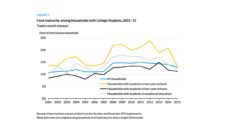Gender differences in mental health are an enduring public health issue. Women are more likely than men to have panic attacks, panic disorder, depression, PTSD, anxiety disorders, mood disorders, and sleep disorders. Women also tend to have more feelings of sadness, hopelessness, anxiety, and worry. Research suggests that the difference in mental health outcomes between men and women is not a sex difference, but a gender difference. That is, social and cultural factors are likely the cause of these differences—not biology.
Women, on average, have lower perceived safety than men in the same settings. Women are twice as likely as men to report being fearful of crime, even though men are more likely to be victimized. One possible explanation for women’s higher fear of crime is the “shadow of sexual assault” hypothesis, which refers to women’s fear that any crime could also result in sexual assault or rape. It is also possible that women are more fearful because they feel more vulnerable or they consider the consequences of crime to be greater. Low perceived safety and high fear of crime can increase distress and worsen sleep quality.
This fear is also common on college campuses. Many college women feel unsafe on campus, most notably due to the fear of sexual assault. In a focus group study, college women reported that feeling unsafe is just part of being a woman.
To examine the relationships between gender, perceived safety, and health, we analyzed the National College Health Assessment, which is a health survey taken by students at colleges and universities nationwide. We found that college women had poorer sleep quality and more psychological distress than college men. Women also reported feeling less safe on campus.
Research suggests that the difference in mental health outcomes between men and women is not a sex difference, but a gender difference. That is, social and cultural factors are likely the cause of these differences—not biology.
Our unique finding is that gender, perceived safety, and mental health are all related. After controlling for personal victimization history, general health, and campus size, we found that low perceived safety accounted for 10% of the relationship between gender and distress as well as gender and poor sleep. In other words, perceived safety on campus is a partial explanation for the differences in mental health between college men and women. These results were not specific to any particular kind of campus.
These results suggest that an increase in perceived safety may benefit mental wellbeing. To increase perceived campus safety, college administrators could improve campus safety features and promote awareness of safety-enhancing services. Perhaps women may also find relief from personal defense measures (for example, self-defense classes) that could increase their perceived safety.
Though our study found a partial explanation for gender differences in mental health, it’s only one piece of the puzzle, explaining about 10% of the relationship. What other factors explain the remaining 90% of gender differences in mental health among college students? The social conditions that cause gender differences in perceived safety may also directly cause gender differences in mental health. Some researchers argue that objective power differences create perceptions of powerlessness in women. Perceived powerlessness may influence both perceived safety and mental health. Further research is needed to explore the relationship between perceived safety and mental health in college students.
Photo by ian dooley on Unsplash
If you have been affected by sexual violence and wish to speak with your nearest sexual assault service provider, call the National Sexual Assault Telephone Hotline (RAINN) at 1-800-273-8255 or visit rainn.org.














